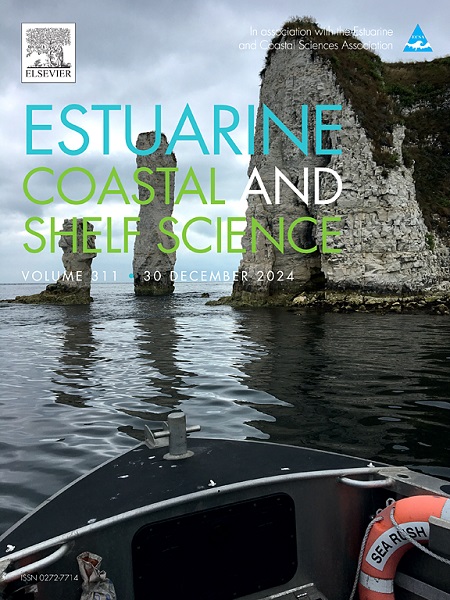热带泥滩食物网中微底栖植物的重要性
IF 2.6
3区 地球科学
Q1 MARINE & FRESHWATER BIOLOGY
引用次数: 0
摘要
泥滩是一种特殊的动态生态系统,处于陆地和水生生态系统的界面,以其巨大的碳储存能力而闻名。泥滩也提供食物来源,构成光合生物和消费群落的重要栖息地。热带泥滩高度不稳定,由于潮汐的影响,水生或空中消费者只能暂时进入,这就提出了这些栖息地的营养功能问题。它们对临时在那里觅食的物种的营养资源以及泥滩食物网的碳来源的重要性值得探索。在一年多的时间里,在一个热带泥滩(法属圭亚那)的两个地点(Sinnamary和Awala-Yalimapo),从初级生产者到捕食者,使用稳定的同位素比率(δ13C和δ15N)作为它们饮食的代表。结果表明,各试验点的营养相互作用相似,季节对小动物群(Halomonhystera sp.)和鱼类(Gobionellus oceanicus仅在Sinnamary)的影响较小。微底栖植物是小动物群的主要来源,也是鱼类的重要来源。3种滨鸟主要依赖于微底栖植物、绿藻和水藻,其次依赖于小动物群。这两种鱼类与鸟类依赖相同的来源,但包含了更高比例的小动物类群(桡足目、线虫目和介形虫目)。对三种滨鸟和两种居鱼物种生态位重叠的分析表明,它们可能会竞争资源。结果讨论了MPB的中心位置,作为这些热带泥滩上绝大多数生物的直接或间接碳源,无论是短暂的还是常驻的物种。本文章由计算机程序翻译,如有差异,请以英文原文为准。
Importance of the microphytobenthos in the foodweb of tropical mudflats
Mudflats are peculiar dynamic ecosystems, at the interface of terrestrial and aquatic ecosystems, known for their large carbon storage ability. Mudflats also provide food source and constitute important habitats for photosynthetic organisms and consumer communities. Tropical mudflats are highly unstable and only temporarily accessible to either aquatic or aerial consumers because of tides, which raises the question of the trophic functioning of these habitats. Their importance in terms of trophic resources for species that temporarily feed there as well as the carbon origin of mudflat foodweb deserve to be explored. This was assessed, over a year in a tropical mudflat (French Guiana) at two sites (Sinnamary and Awala-Yalimapo), from primary producers to predators, using stable isotope ratios (δ13C and δ15N) as a proxy of their diet. The results showed that trophic interactions were similar in each site and only a few influences of the seasons were detected for the meiofauna (Halomonhystera sp.), and fish (Gobionellus oceanicus only in Sinnamary). The microphytobenthos constituted the dominant primary source incorporated by the meiofauna, which in turn was an important one for the fish. The three shorebird species depended mainly on the microphytobenthos, green algae and Tanaidacea and secondarily on the meiofauna. The two resident fishes relied on the same sources as the birds but incorporating higher proportions of the meiofauna taxa (Copepoda, Nematoda, and Ostracoda). The analyses of species niche overlaps between the three shorebirds and the two resident fish demonstrated that they might compete for resources. The results are discussed in relation to the central place of the MPB as a direct or indirect source of carbon for the vast majority of organisms present on these tropical mudflats, whether transient or resident species.
求助全文
通过发布文献求助,成功后即可免费获取论文全文。
去求助
来源期刊
CiteScore
5.60
自引率
7.10%
发文量
374
审稿时长
9 months
期刊介绍:
Estuarine, Coastal and Shelf Science is an international multidisciplinary journal devoted to the analysis of saline water phenomena ranging from the outer edge of the continental shelf to the upper limits of the tidal zone. The journal provides a unique forum, unifying the multidisciplinary approaches to the study of the oceanography of estuaries, coastal zones, and continental shelf seas. It features original research papers, review papers and short communications treating such disciplines as zoology, botany, geology, sedimentology, physical oceanography.

 求助内容:
求助内容: 应助结果提醒方式:
应助结果提醒方式:


